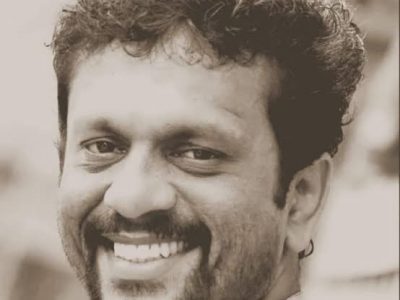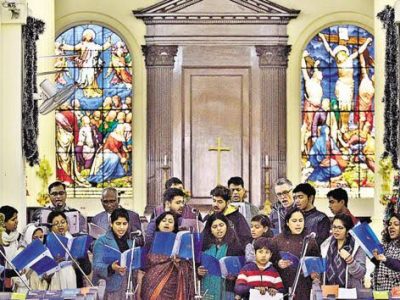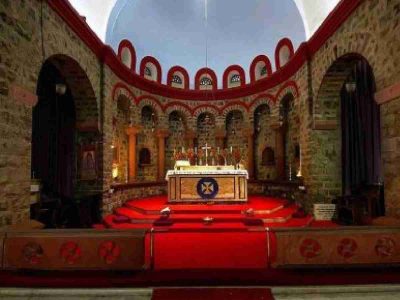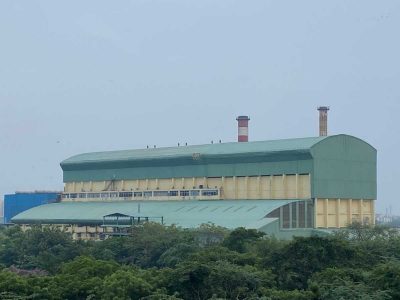With Christmas round the corner and festive mood gripping the Capital, the very inclusive Christian community members are all set to visit churches according to their denominations.
Most of the Christians in Delhi are Protestant (59.22%) with Catholic (33.19%), Syrian Orthodox (7.44%) and other Christians (0.15%) adding up the remaining numbers.
The Protestant Christian community loves to visit churches like the Henry Medd-designed beautiful Cathedral Church of the Redemption (also known as North Avenue Church), near the Rashtrapati Bhavan, the St. Thomas Church, Mandir Marg, and St. Martin’s Church, Delhi Cantonment.
“All these churches have very rich history and generations of Protestant Christian community have visited them on a regular basis for prayers as an article of faith,” says Monodeep Daniyal, who looks after the choir group of North Avenue Church.
He also used to teach theology at St. Stephen’s College.
Both Cathedral Church of the Redemption and Sacred Heart Cathedral, Gole Dak Khana, were designed by Henry Medd, who was among the many young architects who came to New Delhi to assist masters like Sir Edwin Lutyens and Herbert Bakar when work was going on at great pace here to design a series of new buildings in the new British capital in the early part of last century.
While assisting his seniors, Medd made a lasting impact by designing the two landmark churches. His class is evident in the Cathedral Church of the Redemption and the Sacred Heart Cathedral.
Medd, who joined Lutyens’s office here when he was barely 23, was the Chief Architect to Government of India from 1939 to 1947.
Here he was given complete freedom to practice his philosophy of integrating built-form with landscape as a total environmental concept. Every part of these churches speaks a different language. The environment in the courtyard gives a feeling of freshness. Medd planned these churches in a manner to ensure clean look.
Church for Army men
Like many other Protestant Christians, businessman Ajay Solomon keeps visiting St. Martin’s Church at Delhi Cantonment. It is a majestic church built for the Army men and their families in 1929.
It was commissioned by Lutyens to Arthur Gordon Shoosmith, one of the architects involved in the creation of the Capital. It is a stellar example of Indo-British architecture where the techniques of western world were adapted to local materials and climatic conditions.
It was Lutyens’s belief that a building made of a single material would have greater strength and Shoosmith concurred. In keeping with that, Shoosmith used around 35 lakh locally sourced bricks to construct this building.
The end result was a structurally strong and wonderfully utilitarian building whose exterior resembled a fort complete with buttresses and parapets. Shoosmith also designed the St. Thomas Church at Mandir Marg.

Father George Solomon, who served as Father of St. Martin’s Church for many years, informs, “It was built by the British government for Christians serving in the Army and all those living in and around the cantonment area. Once they left India, the church was used by the Protestant Community. When I was there, I used to wonder that the whole area beyond Dhaula Kuan would have a deserted place at the time of its construction.”
The Sacred Heart Cathedral near Gole Dak Khana hosts not just the strong diplomatic community for the Christmas Mass, but also Christians from Northeastern states. The full name of this red colour church is Roman Catholic Church of the Sacred Heart.
In the early days, just after the Capital of India was moved from Calcutta to Delhi, the chaplain of the nascent city envisaged a massive Gothic church on the lines of Westminster Abbey.
Lutyens, the architect of Rashtrapati Bhavan, rejected the concept. He felt that Westminster Abbey, with all its glass windows would only be fit for ‘frying bacon’ in the heat of Delhi summer. Medd, who eventually designed the Cathedral, heeded Lutyens’s warning and that is why the Cathedral does not have many windows.
This church has become a meeting point for the Christians of Manipur, Mizoram, Meghalaya, Tripura, Nagaland and other Northeastern states living in Delhi and NCR.

Informs Ngaoni R James, a Noida-based Manipur Christian, “Members of the Northeastern Catholic community of Delhi love to meet here often. After prayers, the members spend quality time with their families. We feel so good here.”
Church for Anglo-Indians
Meanwhile, the Anglo-Indian community identify themselves with St. James’ Church of Kashmiri Gate and prefer to pray here only. It is considered as the oldest church of Delhi, and was built by James Skinner in 1836. Skinner was an Anglo-Indian himself. The church was there when Mirza Ghalib was around. In its almost two centuries of existence, the church has emerged as a significant link connecting the events and developments of the last days of the Mughal era with the present times.
Himself an Anglo-Indian and historian of Delhi, the late RV Smith used to say that the Anglo-Indian community of Delhi was mostly based in Kashmere Gate and Mori Gate in the early part of last century, and preferred St. James’ Church for attending Sunday Mass and Christmas Mass.
Further, they identify with James Skinner as he was also an Anglo-Indian.
The church nowadays functions under Rt. Rev. Paul Swarup, the Bishop in the Diocese of Delhi of the Church of North India, and the pastoral and administrative care is provided by Rev. Prateek Pillai.
Meanwhile, the Christian community of Christian Colony of Turkman Gate loves to visit the Holy Trinty Church inside their colony. This is considered as the first dedicated Christian colony of Delhi.
St. Stephen’s Church is located on Church Mission Road near Delhi Junction and is not far from St. James’ Church. This church was built in 1862 by the Delhi Brotherhood Society (DBS). Apart from the Protestant Christian community, Christians living in Delhi-6 also visit here.
It was DBS that established St. Stephen’s Hospital and St. Stephen’s College in Delhi. The church is built in typical Gothic style. Apart from its ornate walls and ceilings, the church has a unique feature which is the stained glass rose window.
The St. Mary’s Orthodox Cathedral, Hauz Khas, was built in 1975. It is perhaps the first church of Syrian Christian community.
According to Sakhi John of Jamia Hamdard, “Syrian Christians are mostly based in Kerala. Those who moved to Delhi visit here.”

Late MG George Muthoot, Chairman of Muthoot Finance, India’s largest gold finance company, used to pray here often. He died a couple of years ago when he lost balance and fell down the stairs at his south Delhi home.
Noted author Joseph Gathiya says that Delhi has more than 125 churches and all of them are very revered for the Christian community and others. However, Christians prefer to visit churches which belong to their denomination. This is true for all the Christians across the world.





